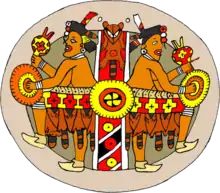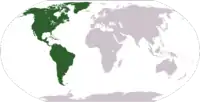Indigenous peoples of the North American Southwest
The indigenous peoples of the North American Southwest are those in the current states of Colorado, Arizona, New Mexico, Utah, and Nevada in the western United States, and the states of Sonora and Chihuahua in northern Mexico. An often quoted statement from Erik Reed (1964) defined the Greater Southwest culture area as extending north to south from Durango, Mexico to Durango, Colorado and east to west from Las Vegas, Nevada to Las Vegas, New Mexico.[1] Other names sometimes used to define the region include "American Southwest", "North Mexico", "Chichimeca", and "Oasisamerica/Aridoamerica".[1] This region has long been occupied by hunter-gatherers and agricultural people.
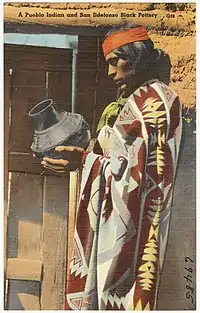
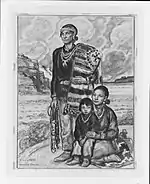
Many contemporary cultural traditions exist within the Greater Southwest, including Yuman-speaking peoples inhabiting the Colorado River valley, the uplands, and Baja California, O'odham peoples of Southern Arizona and northern Sonora, and the Pueblo peoples of Arizona and New Mexico. In addition, the Apache and Navajo peoples, whose ancestral roots lie in the Athabaskan-speaking peoples in Canada, entered the Southwest during the 14th and 15th century and are a major modern presence in the area.
List of indigenous peoples
- Ak Chin, Arizona
- Southern Athabaskan
- Chiricahua Apache, New Mexico and Oklahoma
- Jicarilla Apache, New Mexico
- Lipan Apache, Texas
- Mescalero Apache, New Mexico
- Navajo (Navaho, Diné), Arizona and New Mexico
- San Carlos Apache, Arizona
- Tonto Apache, Arizona
- Western Apache (Coyotero Apache), Arizona
- White Mountain Apache, Arizona
- Aranama (Hanáma, Hanáme, Chaimamé, Chariname, Xaraname, Taraname)
- Coahuiltecan, Texas, northern Mexico
- Cocopa, Arizona, northern Mexico
- Comecrudo Texas, northern Mexico
- Cotoname (Carrizo de Camargo)
- Genízaro Arizona, New Mexico
- Halchidhoma, Arizona and California
- Hualapai, Arizona
- Havasupai, Arizona
- Hohokam, formerly Arizona
- Karankawa, Texas
- Kavelchadhom
- La Junta, Texas, Chihuahua
- Mamulique, Texas, northern Mexico
- Manso, Texas, Chihuahua
- Maricopa, Arizona
- Mojave, Arizona, California, and Nevada
- Pima, Arizona
- Pima Bajo
- Pueblo peoples, Arizona, New Mexico, Western Texas
- Ancestral Pueblo, formerly Arizona, Colorado, New Mexico, Utah
- Hopi-Tewa (Arizona Tewa, Hano), Arizona, joined the Hopi during the Pueblo Revolt
- Hopi, Arizona
- Keres people, New Mexico
- Acoma Pueblo, New Mexico
- Cochiti Pueblo, New Mexico
- Kewa Pueblo (formerly Santo Domingo Pueblo), New Mexico
- Laguna Pueblo, New Mexico
- San Felipe Pueblo, New Mexico
- Santa Ana Pueblo, New Mexico
- Zia Pueblo, New Mexico
- Tewa people, New Mexico
- Nambé Pueblo, New Mexico
- Ohkay Owingeh (formerly San Juan Pueblo), New Mexico
- Pojoaque Pueblo, New Mexico
- San Ildefonso Pueblo, New Mexico
- Tesuque Pueblo, New Mexico
- Santa Clara Pueblo, New Mexico
- Tiwa people, New Mexico
- Isleta Pueblo, New Mexico
- Picuris Pueblo, New Mexico
- Sandia Pueblo, New Mexico
- Taos Pueblo, New Mexico
- Ysleta del Sur Pueblo (Tigua Pueblo), Texas
- Piro Pueblo, New Mexico
- Towa people
- Jemez Pueblo (Walatowa), New Mexico
- Pecos (Ciquique) Pueblo, New Mexico
- Zuni people (Ashiwi), New Mexico
- Quechan (Yuma), Arizona and California
- Quems
- Solano, Coahuila, Texas
- Tamique
- Toboso
- Tohono O'odham, Arizona and Mexico
- Qahatika, Arizona
- Tompiro
- Ubate
- Walapai, Arizona
- Yaqui (Yoreme), Arizona, Sonora
- Yavapai, Arizona
- Tolkapaya (Western Yavapai), Arizona
- Yavapé (Northwestern Yavapai), Arizona
- Kwevkapaya (Southeastern Yavapai), Arizona
- Wipukpa (Northeastern Yavapai), Arizona
History
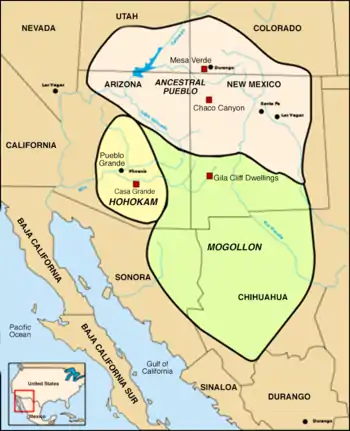
The Pre-Columbian culture of the American Southwest and Northern Mexico evolved into three major archaeological culture areas, sometimes referred to as Oasisamerica.
- The Ancestral Pueblo peoples, or Anasazi, culture was centered around the present-day Four Corners area. Their distinctive pottery and dwelling construction styles emerged in the area around 750 CE.[2] Ancestral Pueblo peoples are renowned for the construction of and cultural achievement present at Pueblo Bonito and other sites in Chaco Canyon, as well as Mesa Verde, Aztec Ruins, and Salmon Ruins.
- The Hohokam tradition, centered on the middle Gila River and lower Salt River drainage areas, and extending into the southern Sonoran Desert, is believed to have emerged in approximately 200 CE. These people lived in smaller settlement clusters than their neighbors, and built extensive irrigation canals for a wide range of agricultural crops. There is evidence the Hohokam had far-reaching trade routes with ancient Mesoamerican cultures to the south, and show cultural influences from these southerners.[3]
- Mogollon peoples /moʊɡəˈjoʊn/ lived in the southwest from approximately 200 CE until sometime between 1450 and 1540 CE. Mogollon archaeological sites are found in the Gila Wilderness, Mimbres River Valley, along the Upper Gila river, Paquime and Hueco Tanks, an area of low mountains between the Franklin Mountains to the west and the Hueco Mountains to the east.
In addition, three distinct minor cultures inhabited the eastern, western, and northern extremes of the area. From 1200 CE into the historic era a people collectively known as the La Junta Indians lived at the junction of the Conchos River and Rio Grande on the border of Texas and Mexico.[4] Between 700 and 1550 CE, the Patayan culture inhabited parts of modern-day Arizona, California and Baja California. The Fremont culture inhabited sites in what is now Utah and parts of Nevada, Idaho and Colorado from 700 to 1300 CE.
Culture
Contemporary Pueblo Indians continue to be organized on a clan basis for pueblo activities and curing rituals.[5] The clans of the eastern Pueblos are organized into the Summer people and the Winter people (Tanoans) or as the Turquoise people and the Squash people. The western Puebloans are organized into several matrilineal lineages and clans. Many Pueblo peoples continue to practice the kachina (katsina) religion,
References
- Cordell, Linda S. and Maxine E. McBrinn 2012 Archaeology of the Southwest, 3rd edition. Left Coast Press, Walnut Creek
- Matson, R (2006). "What is Basketmaker II?". Kiva. 72 (2): 149–165. doi:10.1179/kiv.2006.72.2.002. S2CID 129704711.
- Clark, Jeffery; Lyons, Patrick (2012). Migrants and Mounds: Classic Period Archaeology of the Lower San Pedro Valley. Tucson, Arizona: Archaeology Southwest.
- Miller, Myles R. and Kenmotsu, Nancy A. "Prehistory of the Mogollon and Eastern Trans-Pecos Regions of West Texas." in Perttula, Timothy K. The Prehistory of Texas. College Station: TX A & M Press, 2004, pp. 205–265
- "Pueblo Indians". www.brittannica.com. Retrieved 11 March 2019.
.svg.png.webp)
